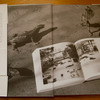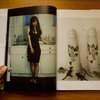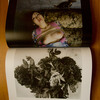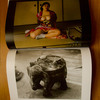Review: It Once Was A Paradise by Nobuyoshi Araki

Somebody once explained to me that writers who seem to be suffering from intellectual rabies (think Ann Coulter or Glenn Beck) live in a world that makes perfect sense to them. For someone on the outside the assumptions and beliefs that everything is based on appear to be almost completely insane. Inside that world, however, things make perfect sense. Of course, such cases are just extreme examples of how we all operate. But seeing this at work fascinates me. In the world of photography, I consider Nobuyoshi Araki to be such a case. Araki is the Mark E. Smith of photography: Both have released so many books (or albums in Smith’s case) that inevitably each article about them cites a mere guess. In Araki’s case, the latest numbers I’ve come across are 425 and 450. What is more, both have carefully cultivated an extremely unusual personality that is at odds with large parts of the world and that might or might not be authentic. (more)
How does one deal with such artists? It seems to me that the worst possible solution is to take things at face value. These artists are what scientists call outliers: Something that statistically speaking is very, very unlikely to happen, but that is still possible. In some way, their creative brain appear to have shortened, and things are erupting in ways that most other people would find impossible to control or deal with. Which means that if you apply the rules by which most people go by to them, you do that at your - not their - own risk: Things simply might not make any sense any longer. Add to that the fact that in Araki’s case, as Westerners we’re dealing with a Japanese artist who operating in a different cultural background, and it becomes obvious pretty quickly that a careful approach is in order.
It Was Once A Paradise might serve as a good entry into the Araki universe. Viewed superficially, the book contains a fairly good sampling of some of the work the photographer has become well-known (or notorious) for: Half of the photographs show women in various states of undress, being either fully or partly tied up in what, I have been told more than once, is some form of Japanese bondage. The other half shows photographs taken on Araki’s balcony: The place itself, littered with plastic toy dinosaurs, and details, including flowers. These latter photographs appear in black and white, whereas the former are in colour. The toy dinosaurs serve as some sort of link between them, since they re-emerge in the bondage photographs. There might be a completely naked woman in a photograph, bound, her legs splayed, with a toy dinosaur right in her crotch. In other words, if you prefer your photography subtle, Araki might not be your cup of tea (speaking of tea, the Japanese have turned making and serving it into a form or art as well).
There are two things to note here. First, Araki has been using this kind of technique, using two seemingly very different images in pairs, for quite some time. He is very aware of how these pairings work, and while some are fairly obvious, others are more complex than they might seem. Second, with the book the artist is very clearly and openly self-referential: The end paper at the beginning of the book shows a photograph of the balcony that contains an open photobook: Inside, there is another image of the same balcony, with the same random assortments of dinosaurs, plus a cat - Araki’s beloved pet (now dead - there’s a book about the cat, of course). The first pair of photographs after the title pages re-uses the game, again the balcony image contains a photobook. That photobook is called “Love and Death,” and the pose of the woman on its cover is mirrored by the pose of the woman in the colour photograph. The stage is thus set, and it’s being filled with more and more pairs of images, flipping orientation halfway through the book (you can actually look at the book like a Japanese book, from the - Western - back to front since there is another title page at the end).
I think a lot of people will find it hard to look past the nudity and the bondage. They might thus miss the fact that Araki actually is a very good photographer. There are quite a few extremely beautiful images in this book, and some of the pairings are amazingly smart. On top of that, It Was Once A Paradise is an incredibly lush production, a beautiful object on its own. So if you want to find out what Araki might be all about and if you don’t know which one of the 400+ books to buy - why not try this one?
It Once Was A Paradise, photographs by Nobuyoshi Araki, essays by Marcel Feil and Robbert Roos, 96 pages, Reflex, 2011









